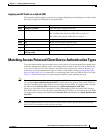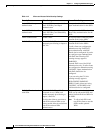
11-20
Cisco IOS Software Configuration Guide for Cisco Aironet Access Points
OL-29225-01
Chapter 11 Configuring Authentication Types
Matching Access Point and Client Device Authentication Types
Table 11-2 Client and Access Point Security Settings
Security Feature Client Setting Access Point Setting
Static WEP with open
authentication
Create a WEP key and enable Use
Static WEP Keys and Open
Authentication
Set up and enable WEP and enable
Open Authentication for the SSID
Static WEP with shared key
authentication
Create a WEP key and enable Use
Static WEP Keys and Shared Key
Authentication
Set up and enable WEP and enable
Shared Key Authentication for the
SSID
LEAP authentication Enable LEAP Set up and enable WEP and enable
Network-EAP for the SSID
1
EAP-FAST authentication Enable EAP-FAST and enable
automatic provisioning or import a
PAC file
Set up and enable WEP and enable
Network-EAP for the SSID
1
If radio clients are configured to
authenticate using EAP-FAST,
open authentication with EAP
should also be configured. If you do
not configure open authentication
with EAP, the following GUI
warning message appears:
WARNING:
Network EAP is used for LEAP
authentication only. If radio clients
are configured to authenticate using
EAP-FAST, Open Authentication
with EAP should also be
configured.
If you are using the CLI, this
warning message appears:
SSID CONFIG WARNING:
[SSID]: If radio clients are using
EAP-FAST, AUTH OPEN with
EAP should also be configured.
EAP-FAST authentication
with WPA
Enable EAP-FAST and Wi-Fi
Protected Access (WPA) and
enable automatic provisioning or
import a PAC file.
To allow the client to associate to
both WPA and non-WPA access
points, enable Allow Association to
both WPA and non-WPA
authenticators.
Select a cipher suite that includes
TKIP, set up and enable WEP, and
enable Network-EAP and WPA for
the SSID.
Note To allow both WPA and
non-WPA clients to use the
SSID, enable optional
WPA.


















